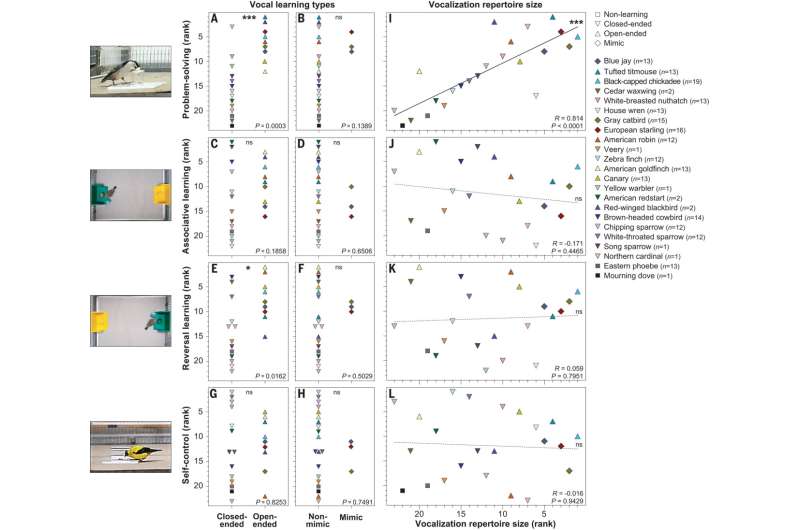This article has been reviewed according to Science X's editorial process and policies. Editors have highlighted the following attributes while ensuring the content's credibility:
fact-checked
peer-reviewed publication
trusted source
proofread
Vocal learning in starlings linked to problem solving skills and brain size

The European starling boasts a remarkable repertoire. Versatile songbirds that learn warbles, whistles, calls, and songs throughout their lives, starlings rank among the most advanced avian vocal learners. Now a new study published in Science finds that starlings, along with other complex vocal learners, are also superior problem solvers.
"There is a long-standing hypothesis that only the most intelligent animals are capable of complex vocal learning," says Jean-Nicolas Audet, a research associate in the laboratory of Erich Jarvis at The Rockefeller University. "If that is true, then complex vocal learners should also be better at cognitive tasks, but no one had ever demonstrated that before."
Only a handful of animal groups are capable of complex vocal learning, roughly defined as the ability to learn and retain a large number of sounds. Humans, elephants, whales, seals, and bats represent most mammalian vocal learners; songbirds, parrots and hummingbirds cover the birds. The Jarvis lab has long focused on songbirds, and ranks their vocal learning complexity across three metrics: how many songs and calls are in the bird's repertoire, whether the bird can continue to learn new songs and calls throughout its life, and whether it can mimic other species.
To determine whether vocal learning is linked to different cognitive abilities in songbirds, Audet and colleagues spent three years catching hundreds of wild birds from 21 species in mist nets at The Rockefeller University Field Research Center, a sprawling 1,200 protected acres of land compromising many different ecosystems in New York's Hudson Valley.
"It's a protected area, which means the animals have limited exposure to humans," says Mélanie Couture, a research assistant who worked on the study. "This is ideal for studying the behaviors of wild birds—what they can do, and how they react to cognitive tasks."
Upon ranking the vocal learning capabilities of their subjects, three frontrunners emerged: starlings, blue jays, and gray catbirds (relatives of mockingbirds). These were also the only three capable of mimicking other species ("the epitome of vocal learning," Audet says).
The team then ran a battery of cognitive tests on 214 birds from 23 species (including two lab-raised bird species that were added to the wild-caught birds). They tested problem-solving abilities by challenging the birds to remove a lid, pierce foil, or pull a stick to retrieve a treat. Self-control was assessed by placing a transparent barrier between each bird and a snack, and recording how long it took the birds to stop butting up against the barrier and go around it. Other tests analyzed whether the birds could learn to associate a certain color with a food reward, and how quickly the birds adapted when the associated color changed.
Statistical analyses revealed a strong correlation between problem solving abilities and vocal learning abilities. Starlings, bluejays, and catbirds were not only the most advanced vocal learners, but also the most adept at solving puzzles, and the better a bird was at working its way around obstacles to nab a treat, the more complex its vocal learning ability. There was no association between the other cognitive tests and vocal learning complexity.
The researchers also found that advanced vocal learners and problem solvers had larger brains relative to the sizes of their bodies—a potential biological basis for the observations.
"Our next step is to look at the brains of the most complex species and try to understand why they are better at problem solving and vocal learning," Audet says. "We have a pretty good idea of where vocal learning happens in the brain, but it's not yet clear where problem solving occurs."
Overall, the findings suggest that vocal learning, problem solving, and brain size may have evolved in tandem, perhaps as a way of increasing biological fitness. Based on these findings, as well as earlier work on the ability of vocal learners to dance to a rhythmic beat, Jarvis is now calling this collection of traits the "vocal learning cognitive complex."
"Our findings help support a previously unproven notion: that the evolution of a complex behavior like spoken language, which depends on vocal learning, is associated with co-evolution of other complex behaviors," Jarvis says.
More information: Jean-Nicolas Audet et al, Songbird species that display more-complex vocal learning are better problem-solvers and have larger brains, Science (2023). DOI: 10.1126/science.adh3428
Journal information: Science
Provided by Rockefeller University





















